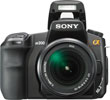Sony Alpha DSLR-A100 review with DT 18-70mm f3.5~5.6
-
-
Written by Gordon Laing
Sony Alpha DSLR-A100 verdict
There’s no denying Sony’s Alpha DSLR-A100 is an impressive camera for the money. Simply having 10.2 Megapixel resolution and built-in anti-camera-shake is enough to elevate it beyond most budget digital SLRs. Throw in a high resolution 2.5in screen and some neat image processing options, along with a kit lens which zooms-in further than the competition, and it’s looking even stronger.
But it’s not all good news. Increasing resolutions on sensors with the same surface area always raises concerns over higher noise levels, and as our results show, the A100 is noticeably noisier than rivals like Canon’s EOS-350D / Rebel XT, particularly at 800 ISO and above. Our gallery also reveals higher noise levels than we’d like even at 400 ISO. It’s interesting to note the A100’s also noisier than the Nikon D200 at high ISOs, despite them sharing essentially the same sensor. To be fair, most people will shoot below 400 ISO, where the A100 performs well, but one of the key selling points of a digital SLR is low noise at high sensitivities.
We additionally had high hopes for the anti dust system, but during our test period, we suffered from several visible marks on images. Until more lenses become available and people start swapping them more often though, it’s hard to tell how effective (or not) the A100’s anti-dust system really is. What we can say for now though is it’s not in the same league as the Olympus SuperSonic Wave Filter.
Then there’s the fact while Sony’s design team have worked miracles in transforming the look of the A100 with only a few tweaks, it still inherits too much from the earlier Konica Minolta 5D for our liking. The screen may be new for example, but the menu design is straight from the ageing 5D and frankly stands out as non-Sony. The battery may also be InfoLithium, but there’s none of the life remaining in minutes you’d find on every other Sony camera. We know the project began as a joint effort between Sony and Konica Minolta, but now the latter’s exited the camera business and Sony’s name is on the front, we’d prefer an unmistakably Sony product. Ultimately the A100 feels more like a Sony-special-edition of the Konica Minolta 5D than a completely new digital SLR system. We feel it would benefit from greater continuity with existing Sony products.
But this aside, lets consider the facts again: 10.2 Megapixel resolution; built-in anti-shake which works with any lens you attach; longer kit lens than normal; high resolution 2.5in screen with information which turns with you, and quick access to a variety of settings. All better than the current budget digital SLR champion, Canon’s EOS-350D / Rebel XT, and all yours for around £699 UK or $999 US. We may not have been convinced by the A100’s D-Range optimiser or anti-dust system, but that’s still a killer line-up in anyone’s book.
Of course the product it finally knocks off the throne is soon to be replaced, although if we were the betting types, we’d gamble the 350D’s successor will, like the EOS-30D, feature little more than a new 2.5in screen and Picture Styles. If this is the case and Canon doesn’t also throw in a budget kit lens with image stabilisation, then Sony could take the lead in the next round. During these times of product transitions though, it’s always worth closely following prices – the 350D / Rebel XT at the time of writing for example could be bought for less than £500 UK or $750 US, and that’s fantastic value even without image stabilisation – see our Canon EOS 350D / Rebel XT review.
As for the Alpha system, we reckon it’s got a very promising future: the debut A100 may be more a hybrid than a completely new camera, but it’s still an impressive proposition none-the-less. We believe the next bodies, once Sony has a chance to properly influence and refine every aspect, have the potential to be better still. We also have high hopes for the forthcoming Carl Zeiss lenses, and it’s a shame they weren’t ready for the launch of the A100 body.
It’s certainly an interesting time in the digital SLR market, with new players shaking-up established brands. We look forward to fully testing Panasonic’s new Lumix DMC-L1 for one, and of course the next generations from Canon and Nikon, the latter already being teased as an affordable 10.2 Megapixel model. Then there’s discounts on older models: if your budget’s tighter, or you demand low noise at high ISOs, then Canon’s 350D / Rebel XT remains your best bet. But for now, even with our caveats, the Sony Alpha DSLR-A100 becomes the best value digital SLR on the market.
 |
NEW: Check out our 10 Megapixel DSLR group test to see how the A100 compares against the Nikon D80 and Canon 400D / XTi, and visit our Budget DSLR Buyer’s Guide for an update of the best buys around right now.
NEW: Check out our Sony 75-300mm lens review tested with the Sony Alpha A100.
Update January 2008 : The A100’s successor, the Alpha A200 has been announced – see our Sony Alpha A200 preview with sample images.
Bad points | Scores (relative to budget DSLRs) |
 | ||
Build quality: Image quality: Handling: Specification: Value:
Overall: |
15 / 20 18 / 20 15 / 20 18 / 20 19 / 20
85% | |||
| ||||




